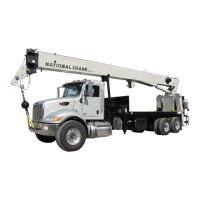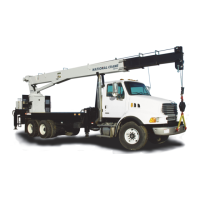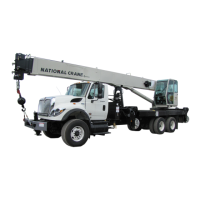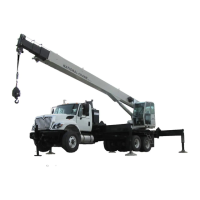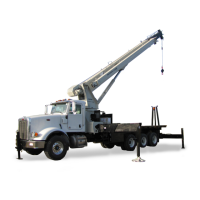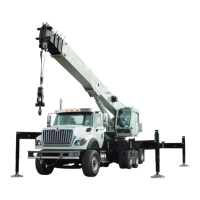OPERATION 800D
2-12
Published 5-27-2018 Control # 039-06
4. The weight of load handling devices is considered as a
part of the load being lifted.
5. The correct loadline reeving is used for the load to be
lifted.
6. Adverse environmental conditions such as wind are not
present.
7. The operator controls the loads smoothly.
8. Tires are inflated to the proper pressure.
9. The load to be handled does not exceed the maximum
capacity at the boom length and loaded radius.
10. The loads are lifted in the proper area around the truck.
A stability test should have been performed on this crane
and can be repeated by referring to the Installation Section.
All capacities are given in direct relationship to the boom
length and loaded radius at which the load is being handled.
All radii are measured from the centerline of rotation to the
loadline with the load suspended. All variances of loads and
radii of operation are shown on the load capacity chart
mounted on the main frame. Boom angle should be used as
reference only to aid in determining radius. The correct
loaded radius must be measured and not exceeded during
any point of the lifting operation. The placard is located at the
operators platform for the purpose of informing the operator
when a load can or cannot be handled. Load ratings cannot
be interpolated between load points shown on the chart in
the boom areas. When boom length or radius or both are
between points listed on capacity chart, the smallest load
shown at either the next larger radius or boom length shall be
used. Capacities of the jib cannot be interpolated between
angles nor at reduced lengths because the strength of the jib
and its attachment point to the boom does not increase when
the boom is shortened.
General
1. The equipment can be hazardous if improperly
maintained or operated. Read and comply with the
Operator Manual supplied with this machine for
information on safety, operation and maintenance
before operating this machine. If these manuals are
missing, order replacements from National Crane
through the distributor.
2. Rated loads shown on the capacity chart pertain to this
machine as originally manufactured and equipped.
Modifications to the machine or use of equipment that is
not factory specified or approved can be hazardous.
Refer to capacity deduction chart for weights which must
be deducted from rated loads when accessories are
attached to boom or loadline.
Set-Up
1. Inspect vehicle and crane including crane operation
prior to use each day.
2. Load ratings shown on the chart are maximum allowable
loads with the crane mounted on a factory approved
truck and all outriggers set on a firm level surface so the
crane is level. This crane is not rated for use without
outriggers.
3. Depending on the nature of the supporting surface,
structural supports under the outrigger floats may be
necessary to spread the load to a larger bearing surface.
4. Always level the crane with the level indicator located at
the operator stations located on either side of the crane
frame.
Operation
1. Operation of this equipment in excess of maximum load
rating and disregard of instructions is hazardous. Always
refer to the capacity chart for load and area limits before
operating the crane. Rated loads at rated radius shall
not be exceeded. Over loading this crane may cause
structural collapse or instability. Do not rely on the RCL
or HCAS system to weigh the load and control limiting
boom angle and radius. Use the system as a backup to
safe operation.
2. Use the angle indicator as a reference only. When lifting
maximum loads, measure radius.
3. Rated loads do not exceed 85% of the tipping load as
determined by SAE Crane Stability Test Code J765a
when mounted on a factory recommended truck.
Structural limited ratings on the capacity chart are
shaded. Stability limited loads are not shaded. Machine
will not always tip before structural damage occurs.
4. Rated loads include the
weight of the hook block,
slings, other lifting
devices and boom
accessories. Their
weights must be
subtracted from the listed
rated load to determine
the net load that can be
lifted.
5. Rated loads are based on freely suspended loads.
Always position the boom tip directly over the load
before lifting. No attempt shall be made to push down
with the boom or move the load sideways in any
direction by pulling or dragging the load.
6. The user shall operate at reduced ratings to allow for
adverse job conditions such as soft or uneven ground,
high winds or erratic operation which produce swinging
BLOCK
SLINGS
+
LOAD
+
TOTAL RATED LOADS
9348
Fo
r
Reference
Only
